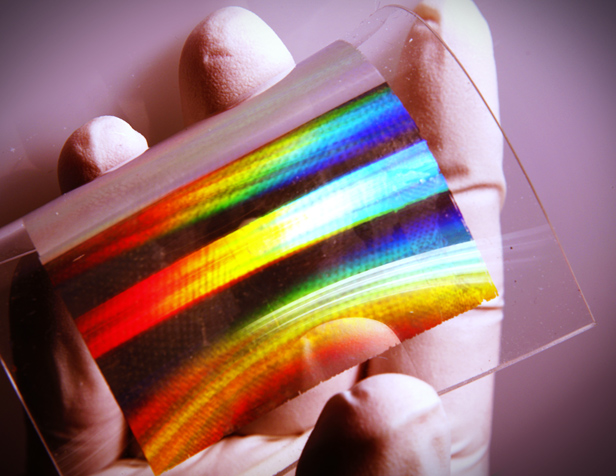The Year in Materials

Tiny crystals called quantum dots emit intense, sharply defined colors. Now researchers have made LED displays that use quantum dots. Five years ago, QD Vision demonstrated its first, rudimentary one-color displays, using the nanoscale crystals. This year it demonstrated a full-color display capable of showing video. The company says it could be another five years before the technology appears in commercial displays. Samsung might get there first—it’s also developing quantum-dot displays, and demonstrated a full-color one in February.
Quantum-dot displays could use far less energy than LCDs. Another ingenious way to reduce energy use is make displays that emit no light at all, but instead reflect ambient light, an approach being taken by Qualcomm with its full-color Mirasol displays, which use only a tenth of the energy of an LCD. The technology has started to appear in tablet computers in South Korea.
No display looks good after it’s covered with fingerprints. A new coating based on soot from a candle flame could provide a cheap oil-repelling layer that could eliminate smudges.
Novel nanostructured materials could greatly enhance the power output of solar panels and make them cheaper by capturing light that would have otherwise been reflected. They could also achieve these goals by converting near infrared light into colors that conventional silicon solar cells can absorb. Another material could render stealth aircraft invisible at night—and invisible to radar night and day.
Metamaterials offer another approach to invisibility: instead of absorbing light, metamaterials bend it around an object. Until this year, researchers have only been able to make metamaterials on a small scale—less than a millimeter across. Now they’ve made them big enough to be practical. They don’t work yet for all wavelengths of light, but they could render objects invisible to night vision equipment.
Stanford researchers built a battery electrode that can be recharged 40,000 times—compared to the 1,000 charges you’d get with a typical laptop battery. Since the electrode lasts so long, and is made of abundant materials, it could provide an inexpensive way to store power from wind turbines and solar panels.
Other researchers have developed inexpensive materials that can store 10 times as much energy as conventional graphite electrodes in lithium-ion batteries. Paired with an equally high-capacity opposite electrode, these could transform portable electronics and electric vehicles. One technology in particular, from Lawrence Berkeley National Laboratory, seems promising because it uses a conductive polymer that can be incorporated into existing manufacturing lines, instead of requiring the expensive new technology for making nanostructures required by others.
New tools could speed the next materials breakthroughs. A modeling program developed at Harvard has led to one of the best organic semiconductors ever made. And a robotic system for making thousands of battery cells with unique electrode chemistries has discovered materials that could boost lithium-ion battery storage capacity by 25 percent.
Keep Reading
Most Popular
Large language models can do jaw-dropping things. But nobody knows exactly why.
And that's a problem. Figuring it out is one of the biggest scientific puzzles of our time and a crucial step towards controlling more powerful future models.
The problem with plug-in hybrids? Their drivers.
Plug-in hybrids are often sold as a transition to EVs, but new data from Europe shows we’re still underestimating the emissions they produce.
Google DeepMind’s new generative model makes Super Mario–like games from scratch
Genie learns how to control games by watching hours and hours of video. It could help train next-gen robots too.
How scientists traced a mysterious covid case back to six toilets
When wastewater surveillance turns into a hunt for a single infected individual, the ethics get tricky.
Stay connected
Get the latest updates from
MIT Technology Review
Discover special offers, top stories, upcoming events, and more.